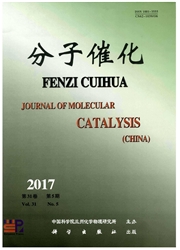

 中文摘要:
中文摘要:
以四磺酸酞菁铜(CuPcTs)为敏化剂,玻璃和图案化的氧化铟锡(ITO)分别作为基底,制备了敏化薄膜TiO2-CuPcTs和ITO/TiO2-CuPcTs/ITO敏化器件.以罗丹明B(RhB)的可见光光催化降解为模型反应评价敏化薄膜的光催化性能.敏化薄膜采用UV-vis和Raman技术进行表征,同时利用敏化器件的结构特性,测定其在氮气和纯水体系下的光电流.研究结果表明,TiO2-CuPcTs可以有效地将光谱响应拓宽到可见光区,一级反应速率常数为空白TiO2薄膜的3.7倍.TiO2-CuPcTs薄膜光催化降解RhB的重复性能稳定.与ITO/TiO2/ITO器件相比,敏化器件ITO/TiO2-CuPcTs/ITO具有较高的光电流信号,验证了激发态的CuPcTs能够将电子转移到TiO导带上的敏化机理.
 英文摘要:
英文摘要:
Using copper phthalocyanine tetrasulfonic acid(CuPcTs) as photosensitizer,two sensitized films TiO2-CuPcTs and ITO/TiO2-CuPcTs/ITO were prepared with glass and patterned indium tin oxide(ITO) as substrates,respectively.The photocatalytic properties of sensitized film were evaluated by photocatalytic degradation of RhB under visible light irradiation as the model reaction.The dye-sensitization films were characterized by ultraviolet-visible spectroscopy and Raman techniques.Based on structural characteristics of sensitized device,the photocurrent of sensitized device ITO/TiO2-CuPcTs/ITO in atmosphere and pure water system were monitored.The results showed that,TiO2-CuPcTs presented intensive absorption in visible-light region.The first-order reaction rate constant of TiO2-CuPcTs film was 3.7-fold as blank TiO2 film.TiO2-CuPcTs film could function stably in the repeated photocatalytic degradations of RhB.ITO/TiO2-CuPcTs/ITO exhibited higher photocurrent than ITO/TiO2/ITO device,which confirmed the sensitization mechanism that the electrons can be transferred from excited CuPcTs to the conduction band of TiO2.
 同期刊论文项目
同期刊论文项目
 同项目期刊论文
同项目期刊论文
 期刊信息
期刊信息
